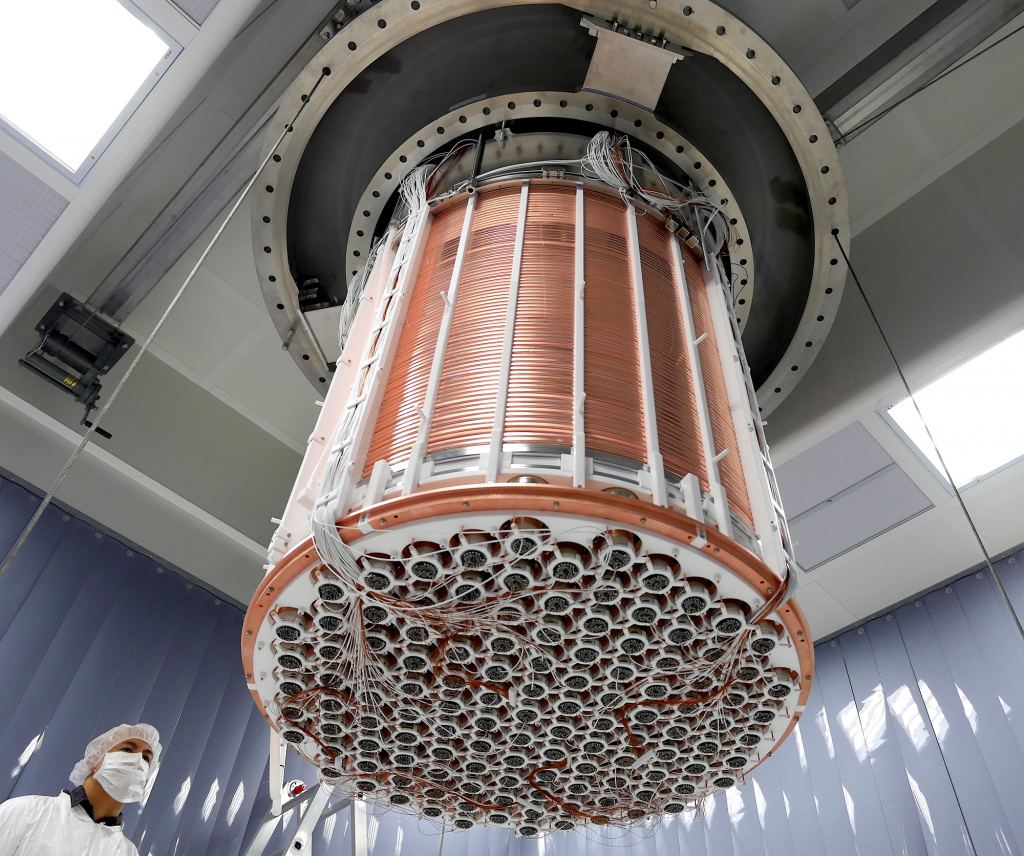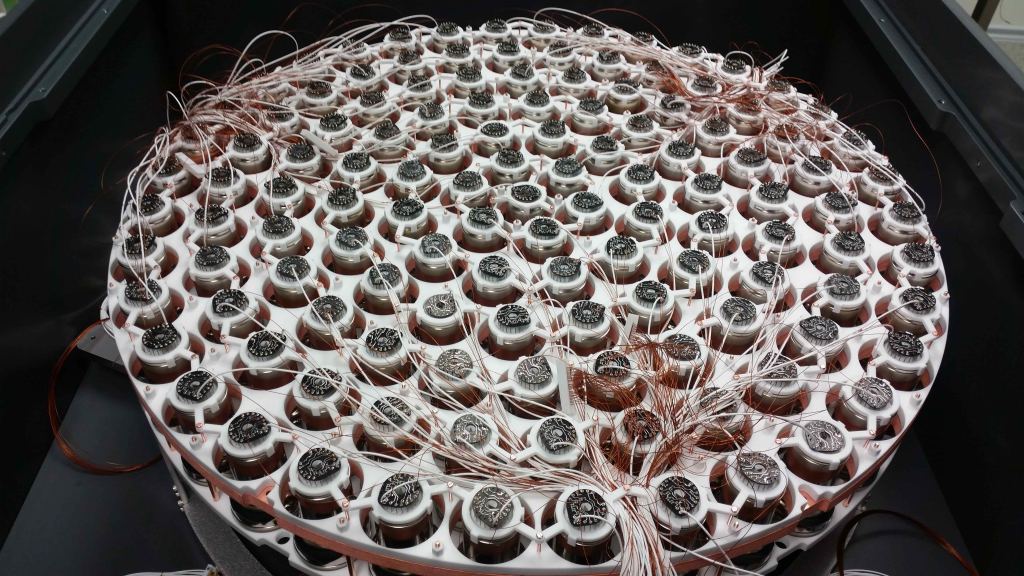About 25 years ago, astrophysicists noticed something very interesting about the Universe. The fact that it was in a state of expansion had been known since the 1920s, thanks to the observation of Edwin Hubble. But thanks to the observations astronomers were making with the space observatory that bore his name (the Hubble Space Telescope), they began to notice how the rate of cosmic expansion was getting faster!
This has led to the theory that the Universe is filled with an invisible and mysterious force, known as Dark Energy (DE). Decades after it was proposed, scientists are still trying to pin down this elusive force that makes up about 70% of the energy budget of the Universe. According to a recent study by an international team of researchers, the XENON1T experiment may have already detected this elusive force, opening new possibilities for future DE research.
The research was led by Dr. Sunny Vagnozzi, a researcher with the Kavli Institute for Cosmology (KICC) at the University of Cambridge, and Dr. Luca Visinelli, a Fellowship for Innovation (FELLINI) researcher (which is maintained with support from the Marie Sklodowska-Curie Fellowship) at the National Institute of Nuclear Physics (INFN) in Frascati, Italy. They were joined by researchers from the Institute de Physique Theórique (IPhT), the University of Cambridge, and the University of Hawai’i.
Both DM and DE are part of the Lambda Cold Dark Matter (LCDM) model of cosmology, which posits that the Universe is filled with cold, slow-moving particles (DM) that interact with normal matter via the force of gravity alone. The Lambda represents DE, which is accelerating the expansion of the Universe. Because neither force interacts with normal matter via electromagnetism or the weak or strong nuclear force, they can only be discerned by observing their effect on the large-scale structure of the Universe.
As a result, astrophysicists and cosmologists are unclear about how DE fits in with the physical laws that govern the Universe. So far, candidates include a modification of Einstein’s General Relativity (GR), the presence of a new field, or a Cosmological Constant (CC). As Dr. Visinelli told Universe Today via email:
“For this reason, dark energy is possibly even more mysterious than dark matter. We see the effects of dark energy through a number of observations, starting from the seminal work on the supernovae 1A as standard candles.Assuming dark energy is indeed a field, the quanta associated with it would be extremely light and carry very little energy. This is the reason why very little work has been devoted to these types of searches.”
In the past, Dr. Vagnozzi and Dr. Visinelli conducted a study that outlined how interactions between dark energy and baryonic (aka. normal) matter could be detected. As they theorized, these interactions would constitute a pure momentum exchange as dark energy and baryons scattered off of each other in a way that would not affect cosmic expansion and evolution.
 The XENON1T detector, shown from below. Credit: XENOX Collaboration.
The XENON1T detector, shown from below. Credit: XENOX Collaboration.
Their work is based on new research that looks beyond the standard LCDM model of cosmology to consider that DE interacts with light by affecting its properties (i.e., polarization, color, direction). However, these interactions could be subject to screening mechanisms that prevent local experiments from detecting them. In this model, it is predicted that dark energy quanta can be produced in the Sun. As Dr. Visinelli explained, the possible connection between screening and dark energy first came to him as he was showing one day:
“I remember it was June 20 and I was having a shower and pondering about solar axions (not) explaining XENON, and I realized the obvious way out was screening, as it would shut down production in denser stars. Screening is usually associated to models of dark energy and/or modified gravity, and there was the “click.” I immediately Whatsapped Luca and we started working on this straight away (and contacted our other co-authors who are experts on screened dark energy/modified gravity models).”
For the sake of their study, the team led by Dr. Vagnozzi and Dr. Visinelli considered the data released by the XENON collaboration, a DM research team made up of 135 investigators from 22 institutions around the world. At the heart of their experiment is a 3,500 kg (7,715 lbs) detector of ultra radio-pure liquid xenon housed within a 10 m (32.8 ft) water tank. Located at the INFN Laboratori Nazionali del Gran Sasso, XENON is also the most sensitive Dark Matter (DM) experiment ever performed.
In 2020, the Collaboration published the results of their experimental run (2016 to 2018), which showed an unexpected rate of electron recoil events. According to the collaboration, this did not constitute a DM detection but could be explained by a tiny residual amount of tritium in the experiment, the existence of a new particle (such as the solar axion), or an unexplained property in neutrinos.
 The top PMT array with all of the electric cables. Credit: XENON Dark Matter Project
The top PMT array with all of the electric cables. Credit: XENON Dark Matter Project
For the sake of their study, however, the team led by Vagnozzi and Visinelli theorized that it may have been the first direct detection of DE. Said Vagnozzi:
“In our model, dark energy possesses peculiar properties: its mass term is related to the density of the environment, so that the denser materials would shield the effects of dark energy, while lighter environments such as the intergalactic space would allow a long-range of the dark energy.
“In this model called “chameleon”, quanta of dark energy are produced in the region of the Sun in which the electromagnetic field is the strongest, the tachocline, which is the region in which the transport of the energy inside the Sun transitions from radiative to convective. The high energy density in electromagnetic radiation in the region allows for a strong coupling with the chameleon field and to its production.”
If true, this would mean that experiments worldwide that are currently geared towards Dark Matter research could also be dedicated to the hunt for Dark Energy. To this end, Dr. Vagnozzi and Dr. Visinelli hope that this study sparks interest in the particle models of DE and that the search for these elusive particles can be carried out in parallel with the ongoing search for DM.
 Illustris simulation, showing the distribution of dark matter in 350 million by 300,000 light-years. Galaxies are shown as high-density white dots (left) and normal, baryonic matter (right). Credit: Markus Haider/Illustris
Illustris simulation, showing the distribution of dark matter in 350 million by 300,000 light-years. Galaxies are shown as high-density white dots (left) and normal, baryonic matter (right). Credit: Markus Haider/Illustris
Even if these experiments are ultimately unsuccessful, they would at least be able to test theories about DE that range beyond the LCDM model, helping scientists to narrow the list of candidates:
“Many other experiments designed for Dark Matter can also carry information about these chameleons, and we hope that designing future setups for these searches will be envisioned. An independent test using cosmological data crossed with the predictions from the chameleon model would also be needed. As for us, we plan to refine the computations in our paper by using a solar model, study the production of chameleons in massive stars, and get in contact with experimentalists for updates.”
Dr. Visinelli is also working with a Ph.D. student in Munich now to develop the theory further. Specifically, they are hoping to predict the implications that interactions between DE and visible matter would have for the large-scale structure of the Universe. Coupled with DE and DM surveys, which will benefit from next-generation telescopes in the coming years, astronomers and cosmologists could be on the verge of shining light on the “Dark Universe”!
Further Reading: Physical Review D

